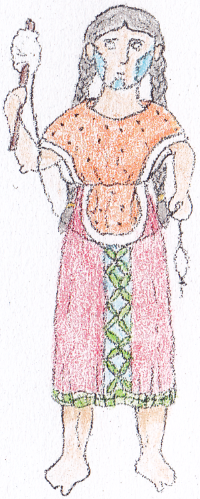Húlpakrans
Húlpakric: Húlpakrö
Pakric: Húlpakrú
Dalran: Húlpakrere
Rexlas: Húlpakrei
Enmohó: Pakrihen
The húlpakrans1 are descendants of Pakrans from Laxilþía who founded colonies in eastern Emlas, along the northwestern coast of Úrtal Sea. They are now subjects of the empire of Dalra, a major power in east Emlas, and are generally content under its rule, as the húlpakrans are renowned for their architects, craftsmen and philosophers.
Most húlpakrans are found in the cities of Silþa, Temekral and Temkí.
The dalrans faced little resistance when they claimed the húlpakran cities as their own, and the latter have thus been treated well, so much so that when the pakran king Pakalos tried to liberate the colonies from Dalra, he was met with apathy at best and had rotten bell peppers thrown at him in some cases.
Jóox is the god of the sky and thunderstorms, and patron deity of Silþa. Húlpakrans in other cities associate him with Aka Ortí, the main god in dalran mythology; he's known as Jóxortos in this form, and controls both lightnings and rainbows.
Zínó is the húlpakran version of Zoníox, love goddess of the pakrans. She's depicted holding an ouroboros in one hand and a scepter shaped like a serpent in the other, and is particularly associated with the city of Temekral.
Divine twin sisters whom húlpakrans trace their lineage to, similar to the hero twins Gróaxalos and Mógrix of the pakrans. They are associated with the sea and sailing, and are protectors of merchants and travelers.
The húlpakrans1 are descendants of Pakrans from Laxilþía who founded colonies in eastern Emlas, along the northwestern coast of Úrtal Sea. They are now subjects of the empire of Dalra, a major power in east Emlas, and are generally content under its rule, as the húlpakrans are renowned for their architects, craftsmen and philosophers.
Most húlpakrans are found in the cities of Silþa, Temekral and Temkí.
History
Before the Dalrans became the dominant culture of eastern Emlas, the pakrans had established colonies along its eastern coast as well as in Laxilþía, competing with their rivals, the Enans, for land, resources and trade routes. The húlpakrans, as the emlantine colonists referred to themselves, became quite wealthy (Temekral in particular) compared to their laxilþían cousins, and their interest in philosophy (especially natural philosophy) rather than traditional pakran mythology meant that latter often viewed (and some still see) húlpakrans as blasphemous hedonists.The dalrans faced little resistance when they claimed the húlpakran cities as their own, and the latter have thus been treated well, so much so that when the pakran king Pakalos tried to liberate the colonies from Dalra, he was met with apathy at best and had rotten bell peppers thrown at him in some cases.
Culture
Apparel
Most húlpakrans are descendants of lowland pakrans, which reflects their traditional clothing: loincloths and cloaks for men, skirts and ponchos or shawls for women, mostly made of cotton or wool. Face- and bodypaint are common, the former are usually blue and the latter often consist of irregular black dots.Art
Architecture
Húlpakran architecture is quite different from traditional pakran style, with emphasis on elaborate friezes and colonnades rather than corbel arches. The Temple of Zínó in Temekral is one of the world's largest shrine, and the largest built by pakrans.Cuisine
Húlpakran diet is a fusion of pakran and dalran cuisines, with emphasis on wheat and barley bread, sweet potatoes, papaya and bell peppers, fish, meat of goats and screamers.Religion
Main deities
Jóox
Jóox is the god of the sky and thunderstorms, and patron deity of Silþa. Húlpakrans in other cities associate him with Aka Ortí, the main god in dalran mythology; he's known as Jóxortos in this form, and controls both lightnings and rainbows.
Zínó
Zínó is the húlpakran version of Zoníox, love goddess of the pakrans. She's depicted holding an ouroboros in one hand and a scepter shaped like a serpent in the other, and is particularly associated with the city of Temekral.
Vomnó and Úloxa
Divine twin sisters whom húlpakrans trace their lineage to, similar to the hero twins Gróaxalos and Mógrix of the pakrans. They are associated with the sea and sailing, and are protectors of merchants and travelers.
Warfare
Though generally not as warlike as the pakrans, húlpakran mercenaries and especially pirates are infamous for being cunning and ruthless in combat, the latter often make themselves more imposing by filing their teeth to make them look like fangs.1Original icelandic: Húlpakrar, singular: Húlpakri












Comments